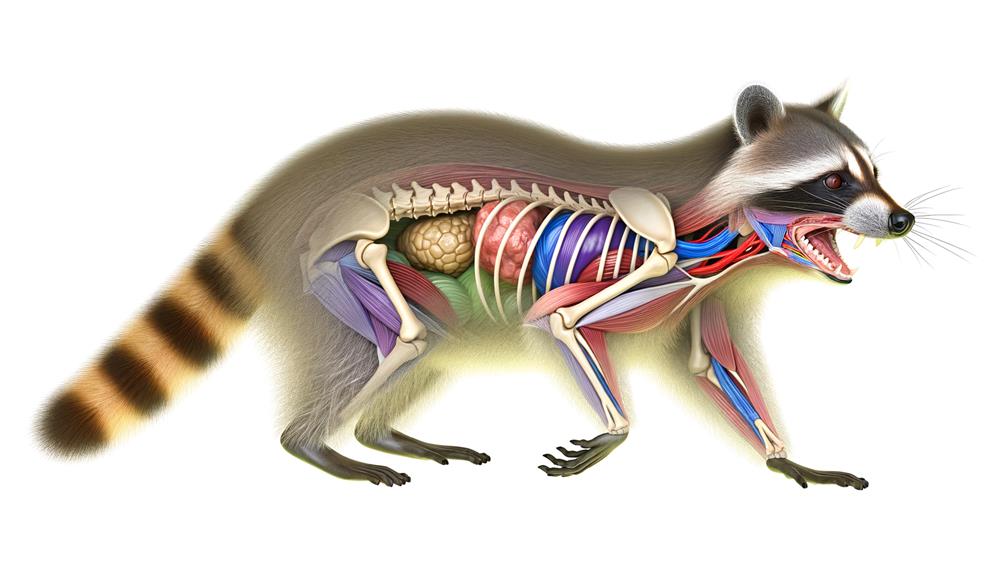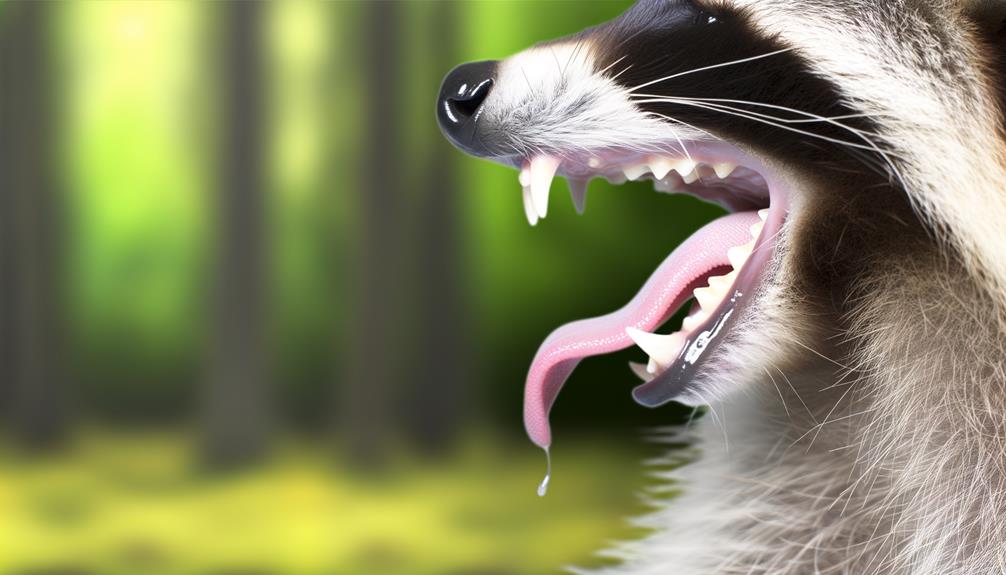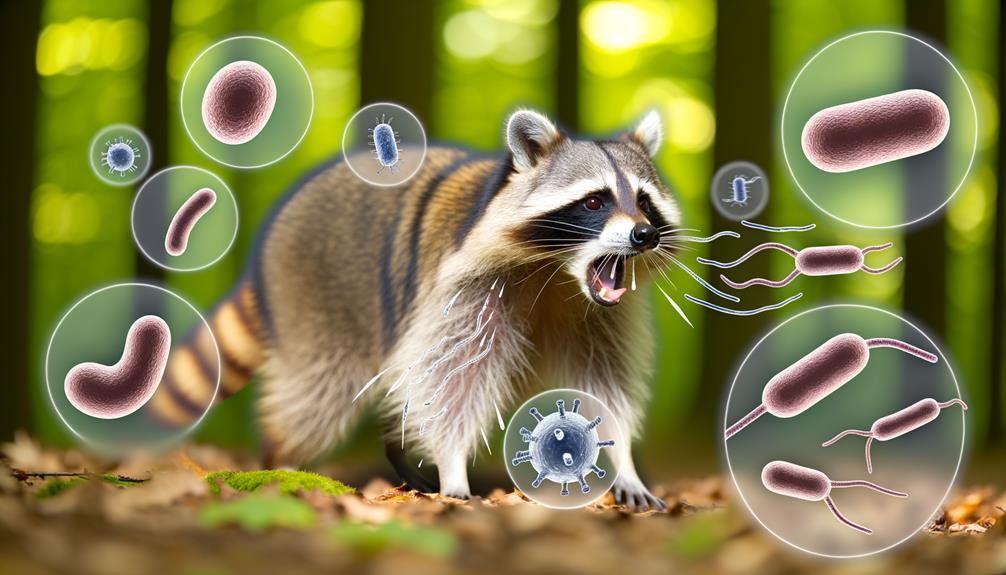Do Raccoons Have Saliva Glands?
Raccoons have three distinct types of salivary glands: parotid, submandibular, and sublingual. The parotid glands secrete a serous fluid rich in enzymes, aiding enzymatic breakdown of carbohydrates.
Submandibular glands produce a mixed serous and mucous secretion, facilitating lubrication and digestion. Sublingual glands primarily generate mucous secretions, contributing to oral lubrication and food manipulation.
Saliva production is under autonomic and hormonal regulation, ensuring optimized oral and digestive health. Each gland's specialized secretions support raccoons' dietary adaptability and interact with their environment.
Explore how these anatomical features influence raccoons' interactions and health.

Key Takeaways
- Raccoons have parotid, submandibular, and sublingual saliva glands.
- These glands produce serous, mixed, and mucous secretions aiding in digestion and oral health.
- Saliva production is regulated by the autonomic nervous system and hormones.
- Saliva contains enzymes like amylase for starch breakdown and mucins for lubrication.
- Raccoon saliva can harbor zoonotic pathogens, posing disease transmission risks.
Raccoon Anatomy Overview

Raccoons (Procyon lotor) exhibit a complex anatomical structure characterized by distinct features that facilitate their omnivorous lifestyle and dexterous behavior. Particularly, their forelimbs possess highly sensitive, tactile receptors, enabling intricate manipulation of objects and food.
The skeletal framework is robust yet flexible, allowing for a wide range of motion in climbing and foraging. Cranially, raccoons have a pronounced sagittal crest, which anchors powerful jaw muscles essential for their diverse diet. Their dentition includes sharp canines and flattened molars, optimized for both carnivorous and herbivorous consumption.
The digestive system is adapted to process various food types, reflecting their opportunistic feeding habits. Moreover, raccoons have an acute sense of smell and vision, which are critical for nocturnal activities and environmental navigation.
Saliva Glands Explained
Saliva glands, also known as salivary glands, play a vital role in the initial stages of digestion by secreting saliva, which contains enzymes like amylase that break down carbohydrates.
There are three primary types of saliva glands: parotid, submandibular, and sublingual, each varying in location and function.
Understanding the anatomical and physiological characteristics of these glands provides valuable insights into their important contributions to the digestive processes in various species, including raccoons.
Function of Saliva Glands
The intricate role of salivary glands encompasses the secretion of saliva, which is vital for initiating the digestive process, maintaining oral health, and facilitating enzymatic breakdown of food. Saliva contains essential enzymes like amylase and lipase, which start the digestion of carbohydrates and lipids respectively. Additionally, saliva aids in lubricating food, forming a bolus for easier swallowing, and exerting antimicrobial effects to protect oral tissues.
| Function | Description | Importance |
|---|---|---|
| Digestive Enzymes | Break down carbohydrates and fats | Initiates digestion |
| Lubrication | Moistens food | Facilitates swallowing |
| Antimicrobial Activity | Contains lysozyme and immunoglobulins | Protects oral cavity |
| pH Balance | Neutralizes acids | Prevents tooth decay |
| Taste Enhancement | Dissolves food molecules | Enhances flavor perception |
Understanding these functions underscores the significant role salivary glands play in overall oral and digestive health.
Types of Saliva Glands
In mammals, salivary glands are categorized into three main types: parotid, submandibular, and sublingual, each contributing distinct secretions that collectively assist oral and digestive functions.
The parotid glands, located near the ears, mainly secrete serous fluid rich in enzymes like amylase, which initiates carbohydrate digestion.
Submandibular glands, found beneath the lower jaw, produce a mixed secretion of both serous and mucous fluids, aiding in lubrication and enzymatic breakdown.
Sublingual glands, situated under the tongue, primarily excrete mucous, enhancing the formation of the food bolus and ensuring smooth passage through the esophagus.
Each glandular type plays an important role in maintaining oral health, initiating digestion, and providing antimicrobial protection. Understanding these distinctions is vital for comprehending mammalian salivary physiology.
Types of Saliva Glands

Raccoons possess three main types of salivary glands: parotid, submandibular, and sublingual, each contributing distinct secretions to facilitate various physiological functions.
The parotid glands, located near the jawline, mainly secrete a watery serous fluid rich in enzymes important for initial food breakdown.
Submandibular glands, positioned beneath the lower jaw, produce a mixed serous and mucous secretion that aids in both enzymatic digestion and lubrication of food.
Sublingual glands, found beneath the tongue, generate mostly mucous secretions, which provide essential moisture for food manipulation and bolus formation.
These differentiated secretions, together, ensure effective oral processing, enhancing the raccoon's ability to consume a diverse diet while maintaining oral health and facilitating subsequent digestive processes.
Saliva Production in Raccoons
Saliva production in raccoons is a finely regulated process involving autonomic nervous system control and hormonal influences, guaranteeing the appropriate volume and composition of saliva is secreted in response to various stimuli.
The parasympathetic and sympathetic branches of the autonomic nervous system regulate the activity of raccoon salivary glands. Parasympathetic stimulation mainly increases saliva flow, characterized by a watery consistency, whereas sympathetic stimulation leads to a reduced flow, producing a more mucous-rich secretion.
Hormonal influences, particularly through the actions of aldosterone and cortisol, further adjust ionic concentrations and overall secretion rates. These mechanisms collectively ensure that raccoons maintain optimal oral and digestive health, reflecting the evolutionary adaptations necessary for their dietary habits and environmental interactions.
Role of Saliva in Digestion

Understanding the mechanisms of saliva production in raccoons provides a foundation for examining its crucial role in digestion, where enzymatic activity and lubrication facilitate the breakdown and transport of food. Saliva contains amylase, an enzyme that catalyzes the hydrolysis of starch into sugars, initiating carbohydrate digestion. Additionally, mucins in the saliva provide necessary lubrication, easing the passage of food through the esophagus.
| Function | Component | Description |
|---|---|---|
| Enzymatic Action | Amylase | Breaks down starch into simpler sugars |
| Lubrication | Mucins | Facilitates smooth transport of food |
| pH Regulation | Buffers | Maintains ideal pH for enzyme activity |
| Antimicrobial | Lysozymes | Protects against pathogenic microorganisms |
| Moistening | Water | Keeps the oral cavity and food moist |
These components highlight the multifaceted role of saliva in raccoon digestion, ensuring effective nutrient absorption.
Adaptations for Diverse Diets
How do the unique physiological and anatomical adaptations of raccoons support their omnivorous dietary habits?
Raccoons exhibit remarkable versatility in their feeding mechanisms, primarily due to their highly dexterous front paws and acute sense of touch, which facilitate the manipulation and examination of diverse food items.
Their dentition exhibits significant adaptation, featuring sharp canines for tearing flesh and flat molars for grinding plant material.
Additionally, raccoons possess well-developed salivary glands that initiate the breakdown of complex carbohydrates and proteins, thereby enhancing their ability to process a wide array of foods efficiently.
Their robust digestive system, including a relatively simple but efficient stomach and a long intestine, further underscores their capability to derive nutrients from both animal and plant sources, reflecting true omnivory.
Impact on Health and Hygiene

The presence of saliva glands in raccoons has significant implications for health and hygiene, particularly concerning zoonotic disease transmission, as raccoon saliva can harbor pathogens like rabies virus.
Saliva also contains antibacterial properties, which play a role in wound healing and could influence the spread of infections.
Understanding the necessity of proper cleaning and taking precautions when dealing with raccoons or their habitats is essential to mitigate health risks.
Disease Transmission Risks
Raccoon saliva glands play an essential role in the transmission of zoonotic diseases, impacting public health and hygiene to a great extent. Rabies virus is a primary concern, as it can be transmitted through raccoon bites or saliva contact with open wounds.
Additionally, raccoon roundworm (Baylisascaris procyonis) poses significant risks, with larvae potentially causing severe neurological damage in humans. Besides, raccoon saliva may harbor Leptospira spp., responsible for leptospirosis, which can lead to renal failure and liver damage.
Studies indicate that the pathogenic load in raccoon saliva is substantial, necessitating strict preventive measures. These observations underscore the vital need for public awareness and effective wildlife management to mitigate the health risks posed by raccoon saliva-borne pathogens.
Saliva's Antibacterial Properties
In addition to their role in disease transmission, raccoon saliva exhibits antibacterial properties that can influence the microbial dynamics within their oral cavity and immediate environment. These properties are mediated by specific enzymes and proteins, including lysozyme and lactoferrin, which target bacterial cell walls and iron metabolism, respectively. The antibacterial efficacy of raccoon saliva can impact not only their own health by reducing oral infections but also the microbial landscape of areas they frequent.
| Antibacterial Component | Mechanism of Action | Impact on Microbes |
|---|---|---|
| Lysozyme | Hydrolysis of peptidoglycan | Disintegration of bacteria |
| Lactoferrin | Iron sequestration | Inhibition of bacterial growth |
| Peroxidase | Oxidative damage | Bacterial cell membrane disruption |
| Defensins | Pore formation in membranes | Bacterial cell lysis |
| Histatins | Inhibition of enzymes | Reduced microbial virulence |
Understanding these properties provides insight into the health and hygiene implications of raccoon saliva.
Cleaning and Precautions
Effective cleaning and precautionary measures are necessary to mitigate potential health risks associated with raccoon saliva contamination. Raccoon saliva can harbor pathogens such as Leptospira spp., which cause leptospirosis, and the rabies virus. Thorough disinfection of contaminated surfaces using EPA-registered disinfectants is vital. Personal protective equipment (PPE) including gloves and masks should be used during cleaning to prevent direct contact with saliva.
Additionally, individuals should avoid handling raccoons and make sure pets are vaccinated against rabies. Hand hygiene, involving thorough washing with soap and water, is essential post-exposure. Analytical studies underscore the importance of community awareness programs to educate about zoonotic disease transmission and the implementation of robust biosecurity protocols to safeguard public health.
Comparative Analysis With Other Mammals
Despite the unique ecological niche occupied by raccoons, their salivary gland structure exhibits remarkable similarities to those of other mammals, providing insight into common evolutionary adaptations.
Comparative anatomical studies reveal that raccoons possess three primary types of salivary glands:
- Parotid glands – These produce a serous, enzyme-rich secretion aiding in the initial stages of digestion.
- Submandibular glands – These secrete a mixed serous and mucous fluid, facilitating lubrication and digestion.
- Sublingual glands – These primarily produce mucous secretions that help in oral lubrication.
These glandular structures are comparable to those found in species such as canines and felines, indicating a conserved physiological function across diverse mammalian taxa. This similarity underscores the essential role of these glands in maintaining oral and digestive health.
Conclusion
Coincidentally, the presence of saliva glands in raccoons not only facilitates essential digestive processes but also underscores their remarkable adaptability to diverse diets.
These anatomical structures, analogous to those in other mammals, highlight a fascinating convergence in evolutionary biology.
The intricate balance between saliva production and dietary needs in raccoons exemplifies a sophisticated physiological adaptation, thereby reinforcing the importance of such mechanisms in maintaining overall health and hygiene.
This convergence evokes a profound appreciation for the complexity of mammalian biology.






